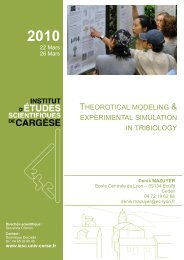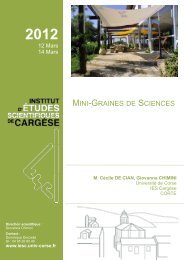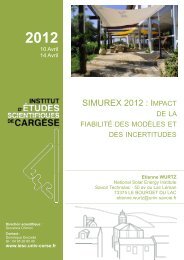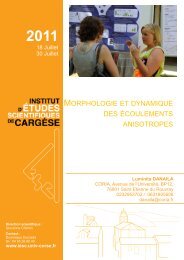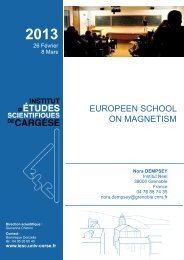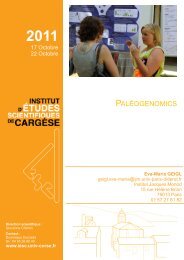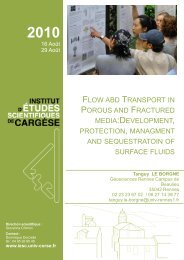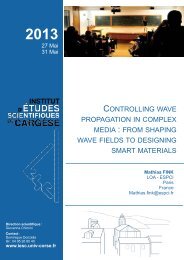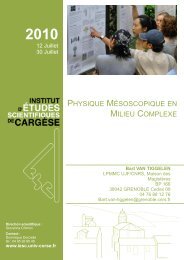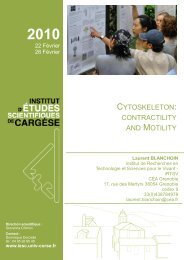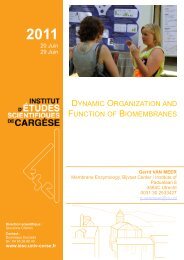nanoelectronics - Institut d'Études Scientifiques de Cargèse (IESC)
nanoelectronics - Institut d'Études Scientifiques de Cargèse (IESC)
nanoelectronics - Institut d'Études Scientifiques de Cargèse (IESC)
Create successful ePaper yourself
Turn your PDF publications into a flip-book with our unique Google optimized e-Paper software.
Thursday<br />
[3] B. A. Bernevig, T. L. Hughes, and S. -C. Zhang, Science 314, 1757 (2006).<br />
[4] M. Konig et al., Science 318, 766 (2007).<br />
[5] C.-X. Liu et al., Phys. Rev. B 83, 035407 (2011).<br />
[6] D. Chevallier et al., Phys. Rev. B 82, 155318 (2010).<br />
[7] B. J. Overbosch and C. Chamon, Phys. Rev. B 80, 035319 (2009).<br />
[8] J. C. Y. Teo and C. L. Kane, Phys. Rev. B 79, 235321 (2009).<br />
[9] A. Strom and H. Johannesson, Phys. Rev. Lett. 102, 096806 (2009).<br />
[10] T. L. Schmidt, Phys. Rev. Lett. 107, 096602 (2011).<br />
_________________________________________________________________________<br />
Spinful Majorana fermions and magnetoelectricity in junctions of 1D quantum wiresuperconductor<br />
heterostructures<br />
Panagiotis Kotetes 1 , A. Shnirman 2 , G. Schön 1<br />
1 <strong>Institut</strong> für Theoretische Festkörperphysik, Karlsruhe <strong>Institut</strong>e of Technology, 76128<br />
Karlsruhe<br />
2 <strong>Institut</strong> für Theorie <strong>de</strong>r Kon<strong>de</strong>nsierten Materie, Karlsruhe <strong>Institut</strong>e of Technology, 76128<br />
Karlsruhe<br />
Recently, the interest in topological quantum computing has grown due to the appearance of<br />
promising platforms for realizing the long sought Majorana fermions. Among the proposals<br />
that seem suitable for engineering Majorana fermions, the most prominent involves a 1D<br />
semiconducting quantum wire in proximity to a bulk s-wave superconductor, where in<br />
addition a Zeeman field is applied. Here we investigate the Josephson effect in TNT and<br />
NTN junctions, consisting of topological (T) and normal (N) phases of semiconductorsuperconductor<br />
1D heterostructures in the presence of a Zeeman field [1]. A key feature of<br />
our setup is that, in addition to the variation of the phase of the superconducting or<strong>de</strong>r<br />
parameter, we allow the orientation of the magnetic field to change along the junction. We<br />
find a novel magnetic contribution to the Majorana Josephson coupling that permits the<br />
Josephson current to be tuned by changing the orientation of the magnetic field along the<br />
junction. We also predict that a spin current can be generated by a finite superconducting<br />
phase difference, ren<strong>de</strong>ring these materials potential candidates for spintronic applications.<br />
Finally, this new type of coupling not only constitutes a unique fingerprint for the existence of<br />
Majorana fermions but also provi<strong>de</strong>s an alternative pathway for manipulating and braiding<br />
topological qubits in networks of wires.<br />
[1] P. Kotetes, A. Shnirman, G. Schön, arXiv:1207.2691.



